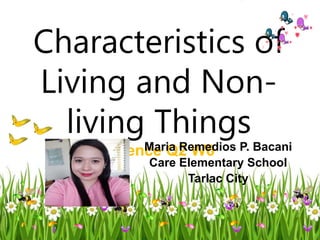CHARACTERISTIC S OF LIVING AND NON-LIVING THINGS SCIENCE Q2 W7.pptx
•Download as PPTX, PDF•
0 likes•10 views
powerpoint
Report
Share
Report
Share

Recommended
Recommended
More Related Content
Similar to CHARACTERISTIC S OF LIVING AND NON-LIVING THINGS SCIENCE Q2 W7.pptx
Similar to CHARACTERISTIC S OF LIVING AND NON-LIVING THINGS SCIENCE Q2 W7.pptx (20)
Living and non living things for national science olympiad

Living and non living things for national science olympiad
Elementary SCIENCE Notes Yr 4 LIVING THINGS AND THE ENVIRONMENT

Elementary SCIENCE Notes Yr 4 LIVING THINGS AND THE ENVIRONMENT
Power Point on Living and Non-Living Things in our environment

Power Point on Living and Non-Living Things in our environment
Recently uploaded
In recent years, the growth of scientific data and the increasing need for data sharing and collaboration in the field of environmental chemistry has led to the creation of various software and databases that facilitate research and development into the safety and toxicity of chemicals. The US-EPA Center for Computational Toxicology and Exposure has been developing software and databases that serve the chemistry community for many years. This presentation will focus on several web-based software applications which have been developed at the USEPA and made available to the community. While the primary software application from the Center is the CompTox Chemicals Dashboard almost a dozen proof-of-concept applications have been built serving various capabilities. The publicly accessible Cheminformatics Modules (https://www.epa.gov/chemicalresearch/cheminformatics) provides access to six individual modules to allow for hazard comparison for sets of chemicals, structure-substructure-similarity searching, structure alerts and batch QSAR prediction of both physicochemical and toxicity endpoints. A number of other applications in development include a chemical transformations database (ChET) and a database of analytical methods and open mass spectral data (AMOS). Each of these depends on the underlying DSSTox chemicals database, a rich source of chemistry data for over 1.2 million chemical substances. I will provide an overview of all tools in development and the integrated nature of the applications based on the underlying chemistry data. This abstract does not necessarily represent the views or policies of the U.S. Environmental Protection Agency.Chemistry Data Delivery from the US-EPA Center for Computational Toxicology a...

Chemistry Data Delivery from the US-EPA Center for Computational Toxicology a...US Environmental Protection Agency (EPA), Center for Computational Toxicology and Exposure
Molecular and Cellular Mechanism of Action of Hormones such as Growth Hormone, Prolactin, InsulinMolecular and Cellular Mechanism of Action of Hormones such as Growth Hormone...

Molecular and Cellular Mechanism of Action of Hormones such as Growth Hormone...Ansari Aashif Raza Mohd Imtiyaz
Recently uploaded (20)
Heat Units in plant physiology and the importance of Growing Degree days

Heat Units in plant physiology and the importance of Growing Degree days
Manganese‐RichSandstonesasanIndicatorofAncientOxic LakeWaterConditionsinGale...

Manganese‐RichSandstonesasanIndicatorofAncientOxic LakeWaterConditionsinGale...
Harry Coumnas Thinks That Human Teleportation is Possible in Quantum Mechanic...

Harry Coumnas Thinks That Human Teleportation is Possible in Quantum Mechanic...
Factor Causing low production and physiology of mamary Gland

Factor Causing low production and physiology of mamary Gland
Chemistry Data Delivery from the US-EPA Center for Computational Toxicology a...

Chemistry Data Delivery from the US-EPA Center for Computational Toxicology a...
SaffronCrocusGenomicsThessalonikiOnlineMay2024TalkOnline.pptx

SaffronCrocusGenomicsThessalonikiOnlineMay2024TalkOnline.pptx
Molecular and Cellular Mechanism of Action of Hormones such as Growth Hormone...

Molecular and Cellular Mechanism of Action of Hormones such as Growth Hormone...
CHARACTERISTIC S OF LIVING AND NON-LIVING THINGS SCIENCE Q2 W7.pptx
- 1. Characteristics of Living and Non- living Things Science Q2 W6 Maria Remedios P. Bacani Care Elementary School Tarlac City
- 2. Objectives: At the end of the lesson, the pupils should be able to: a. identify characteristics of living and non-living things; b. identify the difference between living and non-living things; and c. classify things into living and non- living
- 3. Things Around Us Look up, look up What are above? Sun, moon, stars and clouds. Look down, look down What have you found? Rocks, soil, creatures, small and round
- 4. Look around, look around What do you see? Plants and animals Objects made for you and me
- 5. 1. What is the poem all about? 2. What are the things around us?
- 6. Can you name things that have life? Things that have no life?
- 7. How do you classify things?
- 8. Living things have life. Man, animals, and plants are living things. Living things can grow. Growth refers to increase in size and shape, height or weight. They also need food, air, and water to grow.
- 9. Living things can also reproduce another organisms of their own kind. Living things have the reproductive process while non-living things increase in number or reproduce through the action of external factors like force.
- 10. Some living things can move like man and animals, while others cannot move like plants. Movement is through body parts in many living things. It also refers to the mobility of the object from one place to another by itself, maybe aided by external factors like wind, in the case of flames of fire moving or transferring places.
- 11. Not all moving objects are living things, like cars and robots. Movement may be stationary like trees. Trees shake, branches sway, and leaves move by the forces of wind.
- 12. Non-living things have no life unlike living things. Non-living things cannot grow. They don’t need food, water, and air. Some examples of non-living things are stone, water, air, soil, plastic, dried woods, and rubber.
- 13. These objects are sometimes used as raw materials in manufacturing different products.
- 14. Objects Does it grow? Does it reprodu ce? Does it move by itself? Does it breathe ? Does it need food? Is it a living thing? Is it nonlivin g thing?
- 15. Tell whether the objects is living or non- living things. Write L if it living things and N if it is not. ___1. plate ___6. seahorse ___2. spider ___7. book ___3. bed ___8. earrings ___4. pencil ___9. eagle ___5. squid ___10. leaf
- 16. Thank you!!..